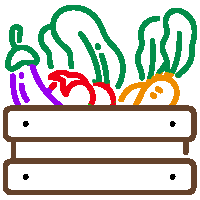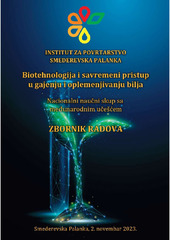Приказ основних података о документу
Medonosne biljke i uticaj pesticida na pčele i proizvodnju meda
Honey-bearing plants and the influence of pesticides on bees and honey production
| dc.creator | Popović, Vera | |
| dc.creator | Bošković, Jelena | |
| dc.creator | Đurić, Nenad | |
| dc.creator | Ikanović, Jela | |
| dc.creator | Filipović, Vladimir | |
| dc.creator | Ljubičić, Nataša | |
| dc.creator | Šarčević Todosijević, Ljubica | |
| dc.date.accessioned | 2023-10-26T11:48:30Z | |
| dc.date.available | 2023-10-26T11:48:30Z | |
| dc.date.issued | 2023 | |
| dc.identifier.isbn | 978-86-89177-06-0 | |
| dc.identifier.uri | http://RIVeC.institut-palanka.rs/handle/123456789/748 | |
| dc.description.abstract | Biljke svojim cvetovima, sokovima i smolama daju pčelama hranu, stvaraju uslove za pravilan život pčelinjeg društva i predstavljaju osnovu za dobijanje pčelinjih proizvoda - meda, cvetnog praha, mleča, voska, propolisa i pčelinjeg otrova. Najzastupljenije medonosne biljke kod nas su: divlji kesten, bagrem, lipa, jorgovan, kupina, facelija, heljda, suncokret, zvezdan, lavanda, neven, žalfija, morač, šafran, itd. Pčele imaju veliki značaj za živi svet na našoj planeti. U poslednje vreme sve je više evidentna ugroženost pčela. Ova studija prikazuje medonosne biljke i efekte koje pesticidi imaju na pčele i njihovu produktivnost. Najčešći put kontaminacije je izloženost pčela agro-hemikalijama koje se koriste za zaštitu useva i njihova primena na useve. Izloženost pčela pesticidima je kroz gutanje ostataka koji se nalaze u polenu i nektaru biljaka. Zbog svega navedenog dati su praktični saveti za izbegavanje štetnih uticaja pesticida u pčelarstvu kako bi se izbegle štetne posledice. | sr |
| dc.description.abstract | Plants, with their flowers, juices and resins, give bees food, create conditions for the proper life of the bee colony and represent the basis for obtaining bee products - honey, pollen, nectar, wax, propolis and bee venom. The most common honey plants in our country are: wild chestnut, acacia, lime tree, lilac, blackberry, phacelia, buckwheat, sunflower, common bird's foot trefoil, lavender, calendula, sage, fennel, saffron, etc. Bees have a great importance for the living world on our planet, lately it is more and more evident bees' endangerment. This study shows honey plants and effects that pesticides have on honey bees and their productivity. The most common way of contamination is exposure of bees to agrochemicals used for crop protection and their application to crops. The exposure of bees to pesticides is through ingestion of residues found in the pollen and nectar of plants. Due to all of the above, practical advice was given to avoid the harmful effects of pesticides in beekeeping in order to avoid harmful consequences. | sr |
| dc.language.iso | sr | sr |
| dc.publisher | Smederevska Palanka : Institut za povrtarstvo | sr |
| dc.relation | info:eu-repo/grantAgreement/MESTD/inst-2020/200032/RS// | sr |
| dc.relation | info:eu-repo/grantAgreement/MESTD/inst-2020/200003/RS// | sr |
| dc.relation | info:eu-repo/grantAgreement/MESTD/inst-2020/200045/RS// | sr |
| dc.relation | info:eu-repo/grantAgreement/MESTD/inst-2020/200358/RS// | sr |
| dc.relation | info:eu-repo/grantAgreement/MESTD/inst-2020/200216/RS// | sr |
| dc.rights | openAccess | sr |
| dc.rights.uri | https://creativecommons.org/licenses/by/4.0/ | |
| dc.source | Zbornik radova : Nacionalni naučni skup sa međunarodnim učešćem Biotehnologija i savremeni pristup u gajenju i oplemenjivanju bilja, Smederevska Palanka 2. novembar | sr |
| dc.subject | medonosne biljke | sr |
| dc.subject | pčele | sr |
| dc.subject | pesticidi | sr |
| dc.subject | honey crops | sr |
| dc.subject | bees | sr |
| dc.subject | pesticides | sr |
| dc.title | Medonosne biljke i uticaj pesticida na pčele i proizvodnju meda | sr |
| dc.title | Honey-bearing plants and the influence of pesticides on bees and honey production | sr |
| dc.type | conferenceObject | sr |
| dc.rights.license | BY | sr |
| dc.citation.epage | 268 | |
| dc.citation.spage | 259 | |
| dc.identifier.fulltext | http://RIVeC.institut-palanka.rs/bitstream/id/2393/bitstream_2393.pdf | |
| dc.identifier.rcub | https://hdl.handle.net/21.15107/rcub_rivec_748 | |
| dc.type.version | publishedVersion | sr |


